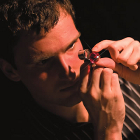From ammolite to zircon

Gemologist Jeff Nechka assesses a gem for clarity and colour. — Dave Blaine, Voyager Photography photo From childhood days spent rock hunting to visi
Gemologist Jeff Nechka assesses a gem for clarity and colour. — Dave Blaine, Voyager Photography photo
From childhood days spent rock hunting to visiting mining sites, Jeff Nechka has spent much of his life immersed in a love of minerals. Studying gems has taken him to some far-flung corners of the world, including South America, Germany and Africa. In 2004, Nechka became a certified gemologist; he took on the Calgary-based Premier Gems in 2007.
If you’re thinking of investing in a gemstone, Nechka recommends finding a gem merchant who is respected in the field.
“You’re looking for gems that show the most vivid colour—basically a pure hue,” he said. “This is what the trade refers to as fine or extra-fine gem material, so it’s a pure red, blue or green colour—you don’t want to have any modifying colours like grey and brown, or secondary hues like yellow or purple. You’re going for a pure, single colour.”
Nechka said that clarity of the gems can be used to identify natural versus synthetic stones, and that inclusions shouldn’t detract from the colour or brilliance of the stone. Certain gems, such as sapphires, can be made more valuable by inclusions.
Nechka said that nearly all gems go through post-mining treatments. This can include heat treatment, surface coating, stabilization and oiling.
“The general public is becoming more aware of enhancements,” said Nechka. “There’s been an increase in disclosure of treatments and enhancements, and (in) making sure that clients are being told if there are any enhancements to their gems.”




